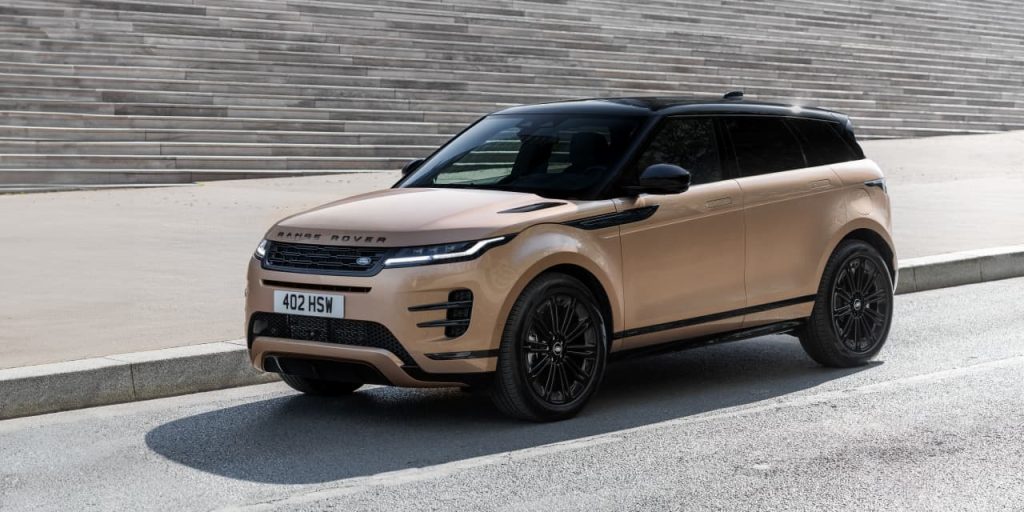While the delineation between standard builds and luxury cars obviously vary in design and performance, there can be aggressive competition between automakers in that top luxury segment to be the boss in technology, materials, bespoke options, and any other element where the details matter for a premium price.
With that in mind, Range Rover proactively upgraded the tech and styling of both its Velar and Evoque for the model year. At a recent demo and drive event in Paris, the minds behind the high-end British SUV builder unveiled what it’s introducing for 2024.
The automaker is putting on a traveling showcase that it’s called the Range Rover House and planted its flag first in the Carmel, California, for the 2023 Pebble Beach Concours d’Elegance, while the most recent edition set up shop at Le Royal Monceau Raffles, a five-star luxury hotel a baguette’s toss from the Arc de Triomphe. Well-heeled Parisian Range Rover enthusiasts had the opportunity to explore the automaker’s technology, textiles, environmental science, and driver safety.
According to Joe Eberhardt, Jaguar Land Rover North America President and CEO, the House of Brands approach distinguishes Range Rover’s personality—while targeting specific client segments.
“For Range Rover, we focus on life’s leaders in business, the arts, or other pursuits,” Eberhardt says. “We see the world becoming more focused on luxury, and there’s an opportunity to go beyond the automotive product and extend our reach to other areas.”
Within recent years, the Jaguar Land Rover (JLR) family divided its lineage officially between four distinct vehicle identities: Jaguar, Land Rover Discovery, Land Rover Defender, and Range Rover. Each of those divisions hold sub brands under those badges. JLR has plans afoot to upgrade all four of its automotive tribes—but the vehicles at the heart of this 2024 model year evolution are the Velar and Evoque—the two SUVs that occupy pricing and size limbs on the Range Rover tree beneath the full-size Range Rover and Range Rover Sport.
“Those seeking more comfort for cruising could lean for Range Rover—while the Sport buyer wants to explore the brand’s dynamic capability,” Eberhardt explains. “The Velar and the Evoque are more at home in urban or city environments because of their more compact size.”
Eberhardt adds that Range Rover sees a higher number of female clients and a more diverse buyer group coming into the brand for Velar and Evoque than its larger offerings.
The Velar amps up its tech by tamping down the fuss with new Active Road Noise Cancellation. The system ensures the Range Rover offers an exceptionally quiet cabin by actively “listening” for intrusive road sounds and selecting a countering signal through the vehicle’s speakers to neutralize the unwanted aural interference.
An optional Cabin Air Purification Plus feature provides cleaner interior air with advanced cabin filtration systems and actively monitored CO2 Management that essentially makes sure the driver is getting clean air while behind the wheel.
For the US$61,500 Velar and the US$49,900 Evoque, all software upgrades for any onboard features arrive automatically via online over-air updates.
All of these tech bells and whistles came to the fore in the new Velar and Evoque because the performance breakdown stays much the same. To hijack a cliche: “If it ain’t broke, don’t fix it.” And Range Rovers certainly aren’t.
The Velar offers both electrified and gas-powered engines. The 3.0-liter, straight-six fossil fuel magic factory delivers 395 horsepower, with acceleration from 0-60 miles per hour in 5.2 seconds. The Ingenium gas 6 six cylinder powerplant is available with a 48-volt MHEV hybrid technology. The 2.0-liter, four-cylinder Velar serves up 247 horsepower, with 0-60 mph time of 7.1 seconds.
The Evoque uses a 2.0-liter, four-cylinder set up with similar numbers to its four-banger Velar cousin, claiming 246 horsepower with its turbocharger chasing down 0-60 in about seven seconds.
In keeping with Range Rover tradition, both models remain fully off-road capable. Any Range Rover (as with their Land Rover relatives) remain the first, best choice for the luxury SUV buyer who wants to motor in comfort and safety in a vehicle that can kick rocks and ford streams if the going gets rougher. Velar and Evoque pack Electronic Air Suspension, Adaptive Dynamics Control, and a chassis system that varies the damping forces at each wheel depending on the terrain.
The driving experience is coded “Range Rover classic.” Both the Velar and Evoque smooth out the pavement below while remaining grounded and perfectly balanced. The smaller Evoque offers a slightly tougher ride because of its smaller wheelbase and lighter weight, but it still moves with stately dignity. While it’s a stretch to refer to either machine as overly sporty, there’s ample power and acceleration in the mix to make both ideal luxury urban transport.
While JLR continues its march toward total electrification within the next decade, its current environmental conservation efforts focus on material science. While traditional leather is still available as an option in the Velar and Evoque, Range Rover now offers Kvadrat wool blends and polyurethane textiles crossing over from modern bespoke tailoring to offer a leather-free cabin for the expected luxurious Range Rover interior.
Nevertheless, if clients want leather, Range Rover can make that available as an option, Eberhardt says. “But, those clients who are more concerned about how their vehicle interacts with the environment, we can offer the option of more environmentally responsible materials. To that end, we really do feel our Kvadrat material compares very well with traditional leather.”
Read the full article here
